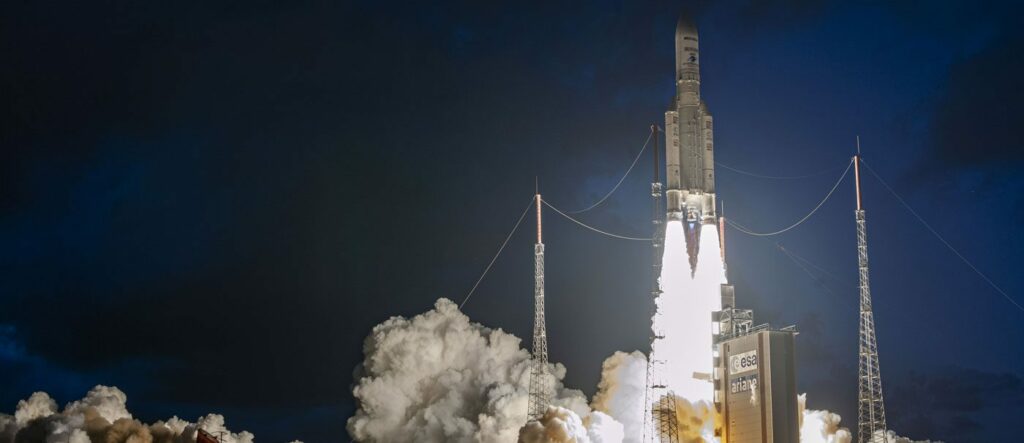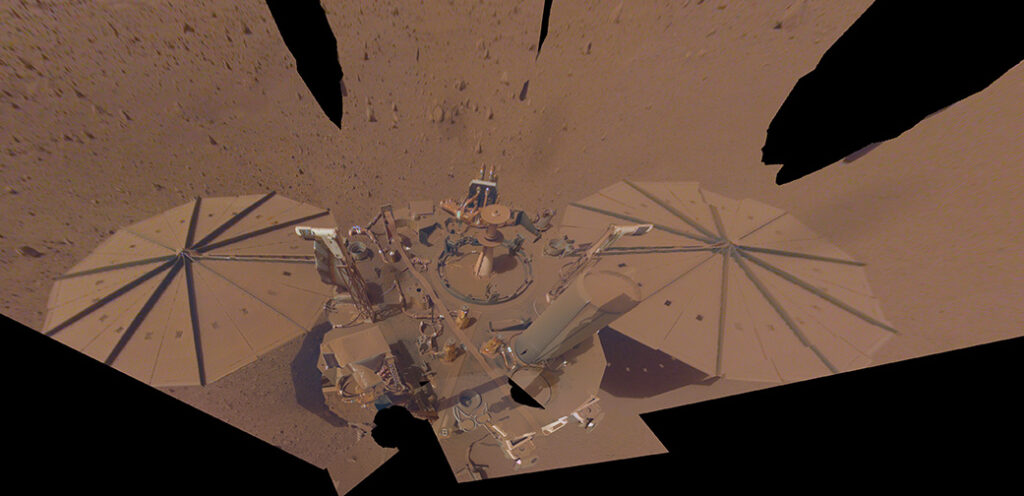A basin region within Margaritifer Terra on Mars contains deposits of clay-bearing sediment that provide evidence of flowing water on the red planet as recently as 2.5 billion years ago. Plus, Mars mission updates, gravitational wave detection, rocket launches, and this week’s What’s Up.
Podcast
Show Notes
First galaxy at the edge of the universe
- An otherwise quiet galaxy in the early universe is spewing star stuff (Science News)
- “ALMA reveals extended cool gas and hot ionized outflows in a typical star-forming galaxy at z=7.13,” Hollis Akins et al., to be published in The Astrophysical Journal (preprint)
Gravity can magnify or reflect distant objects
- Gravitational wave ‘radar’ could help map the invisible universe (Science News)
- “Gravitational Glint: Detectable Gravitational Wave Tails from Stars and Compact Objects,” Craig Copi and Glenn D. Starkman, 2022 June 22, Physical Review Letters
Rocket pollution threatens ozone layer
- NOAA press release
- “The Climate and Ozone Impacts of Black Carbon Emissions From Global Rocket Launches,” Christopher M Maloney, Robert W Portmann, Martin N Ross, and Karen H Rosenlof, 2022 June 1, Journal of Geophysical Research: Atmospheres
Arianespace launches first* mission of 2022
- PDF: VA257 launch kit (Arianespace)
- KASS in operation. What do we expect from it? (GNSS Asia)
InSight to operate seismometer longer
- NASA press release
Instrument on ESA’s Mars Express gets an upgrade
- ESA press release
NASA releases incredible Curiosity images
- NASA JPL image release
Mars sediment reveals long history of flowing water
- PSI press release
- “Clay sediments derived from fluvial activity in and around Ladon basin, Mars,” Catherine M. Weitz et al., 2022 June 3, Icarus
What’s Up: A Stationary Neptune
- Neptune at opposition (In the Sky)
Transcript
Hello from an extremely echoey studio.
These past couple of episodes you may have noticed my recording conditions were less than ideal. This was due to construction on our studio. I am now back in the studio, but if it sounds like we’re bringing you science from an empty, echoey warehouse, it’s because I am the only thing in this studio. Well, me and my script and camera and mic.
There will be one more day of this chaos, and we ask you to all understand. Science sometimes comes from dark echoey places. And we have science and rockets and things for you to view in the sky.
All of this and more, right here on the Daily Space.
I am your host Dr. Pamela Gay.
And we’re here to put science in your brain.

If you ever wanted to know when the first normal-looking galaxy came onto the scene, well, we finally have an answer: at T+ 700 million years, a normal-looking galaxy, cataloged as A1689-zD1, was already on the scene. This system’s light was magnified into our view by the gravity of the galaxy cluster Abell 1689.
This system appears to be forming about thirty stars a year, and the light and wind from those stars are pushing gas out of the system. Using the Atacama Large Millimeter/submillimeter Array (ALMA), researchers could identify the specific light of oxygen and carbon and follow its flow out of the galaxy and into the surrounding circumgalactic space.
This work was presented at the American Astronomical Society meeting by Hollis Akins.
It is amazing that we can use the gravity from galaxy clusters to magnify light from background systems, but galaxy clusters aren’t exactly perfectly formed systems, and the light we see looks like something viewed in a funhouse mirror.
While the suite of telescopes available to this team isn’t able to directly view distant galaxies like A1689-zD1, it is hoped the JWST will be able to. In just three weeks, we will get the first scientific images from this new and massive infrared telescope. Many of us are trying to guess just what those images will show, and I, for one, am hoping for galaxies at the beginning of the universe.

One of the weird things about being a senior scientist is seeing all the things you thought would never happen actually happen. It was twenty years ago this summer that I took the last of the data for my Ph.D. Back then, if you’d asked me if we’d ever be able to study the universe’s first 400,000 years or map the universe in anything other than light, I would have raised a skeptical eyebrow and said, “No. Physics doesn’t work like that.”
The thing is, physics does work like that. Light doesn’t, but what we can’t do with light, we can do with gravity.
Back then, as we all watched LIGO fail to hit deadline after deadline, we just didn’t have a complete appreciation for the fact that we can view the universe in gravity as well as in light, and humans can actually – given enough decades and dollars – build equipment that can detect gravitational waves.
We are not quite a decade into this new era of gravitational wave detection, and already folks are pushing this new area of physics in crazy new directions.
Case in point: Today, I learned the new term “GRADAR”. It’s like radar, but instead of using radio light to see our surroundings, it uses gravity.
A new paper coming out in Physical Review Letters by Craig Copi and Glenn Starkman defines how gravitational waves can be used to map the insides of stars… maybe. After doing a lot of maths that Copi describes as “a very hard calculation”, they were able to determine that the glints of gravitational waves are larger than expected and might be detectable someday in the future. Astronomer Maya Fishback provides this perspective, saying: The whole story of gravitational wave detection has been like that. It was a struggle to do all the math needed to understand their measurements, but now the field is taking off. This is the time to really be creative with gravitational waves.
And I am enjoying watching other folks do the maths I am so grateful I didn’t have to do for homework assignments in grad school. It is amazing how science changes.
As a reminder – there are Ph.D. astronomers out there who pre-date the discovery of galaxies.

We don’t always look at just the launch side of rockets; we also cover their impact on our world. Recently, we covered one team’s study on how the increase in rocket launches is impacting the Earth’s atmosphere. Today’s study comes from a team at the National Oceanic and Atmospheric Administration (NOAA).
The vast majority of orbital rockets currently burn some form of kerosene and liquid oxygen, producing lots of carbon soot which can impact the atmosphere. Rockets are the only way human pollution gets into the upper atmosphere. Currently, about one thousand tons of soot are released from rocket launches every year, and according to researchers, the flight rate of rockets has tripled in the 21st century and is only expected to further increase.
The study modeled ten thousand metric tons of extra soot in the atmosphere, an order of magnitude more than the current level produced by rockets, and found that it would increase global temperatures from between a half to two degrees Celsius. This would change the jet stream and weaken stratospheric circulation.
Although the researchers caution that this study presents a worst-case and that exactly the amount of soot produced by rocket engines is not perfectly understood, the ozone layer will be impacted above 30 degrees north latitude, though not by that much. The maximum ozone reduction was only 4%, over the north pole, in June.
Hydrocarbon fuels are the worst offenders, but hydrogen and oxygen propellant rockets produce water vapor, which also affects the climate. A previous study by one of the same team members looked at these effects, particularly on reusable rockets with high flight rates, and also found an effect on the atmosphere.
With this new study, researchers hope to challenge the perception that solid rockets are the only ones that impact the atmosphere in an appreciable way. Particles from liquid-fueled rockets also have a big impact.
Another environmental impact of spaceflight is heavy metals and other elements from electronics and structures in satellites being deposited into the atmosphere as they burn up. The researchers say further study will be required in this area. We’ll bring those future studies to you here on Daily Space.
Before we get to all the Mars news, we have a quick update on a rocket launch.

On June 21 at 21:50 UTC, Arianespace launched an Ariane 5 from the Guiana Space Centre near Kourou, French Guiana. This was their second launch of the year overall and their first Ariane 5 launch of the year.
Normally, we would show a video of the launch, but there wasn’t any clean footage available that we could find by the time we had to freeze the script for the show. We do, however, have a nice photo taken by one of the Arianespace photographers covering the launch.
Known as VA257, this was the fifth-to-last Ariane 5 to go up and carried its standard complement of two communications satellites to geostationary transfer orbit. One of them, MEASAT-3d, is for the Indonesian company MEASAT and will provide Internet and other services to the nation. In addition to serving Indonesia, the satellite also hosts a small payload for the South Korean company KTSAT, which will be used to provide more precise navigation signals for aircraft.
The second, and smaller, satellite (Ariane 5 generally launches one large and one small satellite) was another communication satellite, GSAT-24. Owned by the Indian government through its company NSIL or New Space India Limited, its capability in Ku-band will be leased to private companies in India to provide broadcasting and communications services.
Both satellites plus the dual launch adapter weighed 10,863 kilograms. The four remaining Ariane 5 launches will consist of three more pairs of commercial satellites. Ariane 5 will go out on a high note with ESA’s JUpiter ICy moons Explorer, or JUICE, the first large-class mission in ESA’s Cosmic Vision 2015-2025 program, which is set to launch sometime in 2023.
And now let’s get to all that news about Mars and its missions.
Let’s start this Mars segment off with some updates on missions.

First up, NASA’s InSight mission team has decided to make some changes to the final operations of the lander in order to get more scientific data out of the mission. Due to the increasing amount of dust on the solar panels, the lander has powered down various instruments to conserve battery life as long as possible. The plan was to let the lander run until December of this year.
Now, however, the seismometer will continue operations until August or possibly September. This will cause the battery to run down more quickly but also allow for the collection of more data. To keep the seismometer up and running, InSight’s team is going to turn off the fault protection system. This means that, in the event of a sudden, unexpected, and potentially hazardous event, the fault protection system will be unable to trigger safe mode for the lander.
Since InSight is in its last few months of operations, it seems reasonable to make this change to keep the science coming. Project manager Chuck Scott notes: The goal is to get scientific data all the way to the point where InSight can’t operate at all, rather than conserve energy and operate the lander with no science benefit.
We’ll bring you more updates as NASA releases them.

Meanwhile, up in orbit around Mars, another mission is receiving an upgrade, which sounds impressive when you consider the distance involved. Or possibly less impressive when you learn it’s a software upgrade. That sounds much easier to implement at a distance.
Launched back in 2003, ESA’s Mars Express spacecraft has been studying the red planet for nearly twenty years. One of the instruments onboard is the Mars Advanced Radar for Subsurface and Ionospheric Sounding or MARSIS instrument. This particular bit of Mars Express played a huge role in the discovery of liquid water on Mars, which includes a suspected subsurface 20-by-30 kilometer briny lake near the south pole.
MARSIS uses a 40-meter-long antenna to send low-frequency radio waves at the planet. Those waves reflect off the surface for the most part, but some travel into the crust and get reflected back where different materials meet. Based on the different distances the beams travel, scientists can map Mars to a depth of several kilometers and even determine the thickness and composition of various layers.
But this amazing instrument was designed using Windows 98, and the mission team decided it was long past time for an upgrade. New software is being implemented that will improve signal reception as well as onboard data processing. Deputy PI Andrea Cicchetti explains: Previously, to study the most important features on Mars, and to study its moon Phobos at all, we relied on a complex technique that stored a lot of high-resolution data and filled up the instrument’s on-board memory very quickly. By discarding data that we don’t need, the new software allows us to switch MARSIS on for five times as long and explore a much larger area with each pass.
Due to the new upgrades and the low cost of operations, Mars Express will continue to be a martian workhorse for years to come.

Before we get to today’s Mars science story, we have one more mission to talk about. This week, NASA released some amazing panoramas and other images of Mars taken by the Curiosity rover. These images reveal sulfate-bearing rocks, boulders deposited by ancient streams, flaky and layered rocks, and rocks where sand scoured the surface and left behind tracks.
The ten-year-old rover is having a few issues of its own these days, though. Recently, Curiosity went into safe mode when a control box read as warmer than expected. The situation only lasted two days, and engineers suspect a faulty temperature reading from a sensor.
On top of that, Curiosity’s wheels are suffering from the wear and tear expected after ten years on Mars, roving over the hard and sometimes hazardous ground. The mission team will continue to have the rover take pictures of the wheels every 500 meters to assess the damage. However, project manager Megan Lin remains unconcerned, stating: We have proven through ground testing that we can safely drive on the wheel rims if necessary. If we ever reached the point that a single wheel had broken a majority of its grousers, we could do a controlled break to shed the pieces that are left. Due to recent trends, it seems unlikely that we would need to take such action. The wheels are holding up well, providing the traction we need to continue our climb.
Good luck, Curiosity, and safe travels.
We’ll have a link to those images in our show notes at DailySpace.org. Make sure to give them a look as they really are impressive.
And now, for some actual Mars science.

A new paper published in the journal Icarus and led by Cathy Weitz provides evidence for a long history of flowing water in a region of Mars known as Ladon basin. The basin contains deposits of clay-bearing sediments. Weitz notes: The presence of clays indicates an environment favorable for life because clays form and remain stable under neutral pH conditions where water persists long-term that minimizes evaporation to form other minerals like sulfates.
Using several instruments and imagers onboard the Mars Reconnaissance Orbiter, Weitz and her team identified the clay-bearing deposits. These clays initially formed up in the nearby highland terrains and collected at the bottom of a lake in the basin, just as sediment does here on Earth. The basin surface is relatively flat, meaning the lake persisted for a long period of time. Additionally, Weitz explains: We found that the Ladon basin region… records a long history of flowing water beginning relatively early in Mars history around 3.8 billion years ago that continued until up to 2.5 billion years ago, which is considered relatively recent.
A nice low-energy lake sitting around for about a billion years? Sounds like a great place to search for signs of past life.
While you can’t go to Mars and check out this amazing site with your own eyes, you can look up and see Mars in the night sky.
What’s Up

This week in What’s Up is another grab bag of events that will happen in the upcoming week. Let’s start with planets.
Mercury will be four degrees from the Moon on June 27.
Neptune, one of the two ice giants that we definitely should have sent a major orbiter and atmospheric probe mission to yesterday, will be stationary on June 28. Contrary to the dozens of Google search results about astrology Erik found when researching this subject, this term has no special meaning.
Stationary means the planet appears to stop moving in the sky, as viewed by an observer standing on the surface of Earth. This event happens only for a day or so, and then Neptune will appear to move backward because Earth completes an orbit quicker than Neptune does. So at some point in Earth’s orbit, Earth seems to be ahead of Neptune, and Neptune moves in retrograde, though in reality, both planets are moving in the same direction.

This same effect happens with all planets relative to Earth at different points in their orbits, most famously Mercury. But no, retrograde motion doesn’t have any effect on your life.
Finally, the New Moon will be on June 29. This is the perfect time to see those faint fuzzies in the sky without the Moon washing out your view. There are lots to see up in the sky, especially because the Earth is in a position to see the disk of the Milky Way pitched across the sky right now. We are looking through the densest part of the Milky Way filled with all of the most exciting things to see in binoculars or a telescope of any size.
As always, go outside and look up.
This has been the Daily Space.
You can find more information on all our stories, including images, at DailySpace.org. As always, we’re here thanks to the donations of people like you. If you like our content, please consider joining our Patreon at Patreon.com/CosmoQuestX.
Credits
Written by Pamela Gay, Beth Johnson, Erik Madaus, and Gordon Dewis
Hosted by Pamela Gay, Beth Johnson, and Erik Madaus
Audio and Video Editing by Ally Pelphrey
Content Editing by Beth Johnson
Intro and Outro music by Kevin MacLeod, https://incompetech.com/music/


 We record most shows live, on Twitch. Follow us today to get alerts when we go live.
We record most shows live, on Twitch. Follow us today to get alerts when we go live.